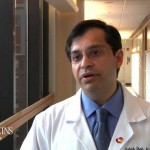Category: Cardiac surgery/transplantation
A modern medical wonder finishes second in the U.S. Open golf tournament
 June 15, 2014- By Steven E. Greer, MD
June 15, 2014- By Steven E. Greer, MD
34-year-old Erik Compton finished tied for second in the United States Open golf tournament. That was a good accomplishment by any standard, but it was also a genuine feat of modern medicine and surgery because he is living on his third heart. Read more »
Robotic surgery and controversies
January 24, 2014- Dr. Dutson gives an update on the referral patterns and safety concerns over the Da Vinci system.
Produced, Interviewed by Steven E. Greer, MD
We interviewed UCLA’s Erik Dutson, MD, surgeon and Director of UCLA’s Center for Advanced Surgical and Interventional Technology (CASIT), about the Intuitive Surgical da Vinci robotic system, and recent safety controversies.
Occluding the left atrial appendage to prevent stroke in A-fib
Thromboembolic stroke caused by atrial fibrillation is the primary reason patients are placed on anticoagulation. However, those blood thinners also carry significant bleeding risks. As a result, various mechanical surgical approaches have been tried to prevent stroke, and obviate the blood thinners.
The newly approved Boston Scientific Watchman left atrial appendage occlusion device aims to prevent clots from forming and migrating to the brain. We interviewed Dr. William O’Neill of Henry Ford Hospital, a leading interventional cardiologist, about the Watchman, and whether it will truly allow patients with A-fib to stop warfarin or other blood thinners.
A Bridge Too Far: Patient classifications for LVAD reimbursement
 September 16, 2013- By Ashish Shah, MD, Cardiac transplant surgeon, The Johns Hopkins Medical Center
September 16, 2013- By Ashish Shah, MD, Cardiac transplant surgeon, The Johns Hopkins Medical Center
Left ventricular assist devices (LVADs) arose from the ashes of the total artificial heart era. The idea of a permanent mechanical solution was abandoned in the 80’s after very public cases involving the Jarvik 7 total artificial heart. However, a few teams utilized the same technology to temporize critically ill patients until a donor heart was available. This effectively “bridged” them to heart transplant.
Throgh the 90’s, attention turned to univentricular support rather than total replacement. These LVADs serve to bridge the patient until they are well enough to be listed for heart transplant: bridge to transplant (BTT). After the publication of the REMATCH trial in 2001, a new class of LVAD patients were defined. Destination therapy (DT) represents the idea that a patient is actually not a candidate for transplant. The LVAD is the final therapy.
The BTT patients typically look like good heart transplant candidates but have run out of time or have reversible end organ dysfunction like renal insufficiency, malnutrition, or pulmonary hypertension that need the support period to improve their post transplant outcome. The DT patients on the other hand, may be older with a greater burden of extra cardiac organ dysfunction.
Over the last decade, Read more »
Managing stroke and bleeding with LVAD patients
Interviewed by Steven Greer, MD
August 2, 2010- As continuous flow pump LVAD devices are being implanted for longer periods of time in destination therapy indications, such as with Dick Cheney, unique problems of hypertensive stroke and bleeding need to be prevented. Dr. Slaughter explains how.
Update November 26, 2013- The NEJM published an abstract from the Cleveland Clinic that reports much higher rates of pump thrombosis in the HeartMate 2. The New York Times wrote about it.
Bud Frazier, MD discusses LVADs (Left Ventricular Assist Devices)
Interviewed By Steven Greer, MD
Dr. Frazier discusses ventricular assist devices such as the Thoratec HeartMate 2.
Joshua Hare, MD: Stem cells to repair myocardial infarcts
August 12, 2010
Interviewed by Steven Greer, MD
Dr. Joshua Hare, Director of the Interdisciplinary Stem Cell Institute, University of Miami Health System, discusses a recent study published testing stem cells to repair myocardial infarcts. They used a porcine infarct model to follow mesenchymal stem cells injected into MI’s. The infarct areas diminished and heart function improved. Moreover, the stem cells seemed to be the cause for the recovery rather than nonspecific inflammation.
Mark Slaughter, MD: the HeartMate 2 trial
Dr. Slaughter, Chief of Cardiothoracic Surgery at Louisville, discusses the new Thoratec HeartMate II destination therapy data presented at the AHA 2009 meeting.
What type of stent did Bill Clinton receive?
February 12, 2010
Bill Clinton underwent a PCI procedure yesterday whereby he received two coronary stents, likely the drug-eluting variety as opposed to bare metal scaffolds. The hospital was part of the Columbia University system and the interventional doctors there are the group behind the TCT conference and the CRF. The stent preferences of those doctors make it highly likely that President Clinton received the Abbott/Boston Scientific Xience stent. Second-hand sources have told The HCC that Xience was the brand, although the actual implanting doctors have not confirmed this, nor should they given medical privacy laws.
Xience is a polymer-based stent like the first generation Cypher and Taxus. The key drug that elutes over time and inhibits restenosis is everolimus. Because of the polymer, these types of stents cause the artery to not properly heal in many cases (i.e. late malaposition or aneurysm), requiring the patient to take lifelong blood thinners like Plavix (clopidogrel). The downside to these anticoagulant drugs are side effects including easy bruising, fatigue, and life-threatening serious bleeding including stroke.
Bare metal stents could have been used as well. The current diameter size offerings of the drug eluting stents are often not large enough to match the vein graft dimensions of restenosed CABG vessels. Charles Bush, MD, interventional cardiologist at the Ohio State University Medical Center, estimated that in their cath labs one third of vein grafts receive bare metal stents.


